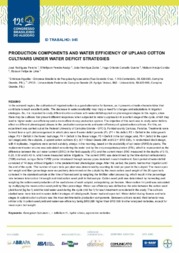Production components and water efficiency of upland cotton cultivars under water deficit strategies.
Production components and water efficiency of upland cotton cultivars under water deficit strategies.
Author(s): PEREIRA, J. R.; ARAÚJO, W. P.; ZONTA, J. H.; GUERRA, H. O. C.; CORÃO, M. A.; LIMA, R. F. de
Summary: In the semiarid region, the cultivation of irrigated cotton is a good alternative for farmers, as it presents climatic characteristics that contribute toreach excellent yields. The decrease in water availability may imply a need for changes and adaptations in irrigation strategies. So, it is important to study different cotton cultivars with water deficit applied on phenological stages in this region, since there may be cultivars that present different responses when subjected to water suppression in a certain stage of the cycle, which may lead to higher water-use efficiency and a more efficient crop production system. The objective of this work was to study water deficits effect on different phenological phases in the production components and water efficiency of upland cotton cultivars. For this, an experiment was carried out at the Federal University of Campina Grande - UFCG, Pombal county Campus, Paraíba.
Publication year: 2019
Types of publication: Abstract in annals or event proceedings
Unit: Embrapa Cotton
Keywords: Algodão, Cotton, Gossypium Hirsutum, Irrigation, Stress hídrico, Variedade
Observation
Some of Embrapa's publications are published as ePub files. To read them, use or download one of the following free software options to your computer or mobile device. Android: Google Play Books; IOS: iBooks; Windows and Linux: Calibre.
Access other publications
Access the Agricultural Research Database (BDPA) to consult Embrapa's full library collection and records.
Visit Embrapa Bookstore to purchase books and other publications sold by Embrapa.

